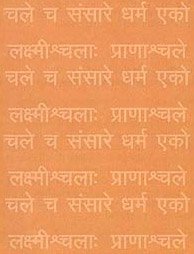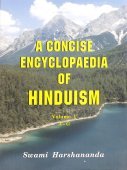Nimittakarana, Nimittakāraṇa, Nimitta-karana, Nimittakaraṇa: 12 definitions
Introduction:
Nimittakarana means something in Hinduism, Sanskrit, Buddhism, Pali, Marathi. If you want to know the exact meaning, history, etymology or English translation of this term then check out the descriptions on this page. Add your comment or reference to a book if you want to contribute to this summary article.
In Hinduism
Nyaya (school of philosophy)
Source: Shodhganga: A study of Nyāya-vaiśeṣika categoriesNimittakāraṇa (निमित्तकारण) refers to “efficient cause” and represents one of the three types of kāraṇa (cause) according to the Tarkasaṃgraha.—The third kind of cause is nimittakāraṇa (efficient cause). According to Śivāditya this kind of cause is different from both the inherent cause and non-inherent cause. Nimittakāraṇa is known as sahakārikāraṇa also because, this cause helps the material to become the effect. For example, conscious agents like the potter, weaver etc. potter’s wheel, stick, weaver’s shuttle, loom etc. in the production of pot or cloth are nimittakāraṇas. The same definition is given by Viśvanātha and Annaṃbhaṭṭa. Thus, Annaṃbhaṭṭa says that nimittakāraṇa is that which is different from the both.70 For example, the shuttle, loom etc. are the efficient causes of cloth.
According to the Nyāya-Vaiśeṣikas, the efficient cause or nimittakāraṇa is divided into two kinds–one is general and the other is special. General cause is those which are common to all effects. General cause is of eight types viz. God’s knowledge, God’s will, space (dik), time (kāla), merit, demerit, prior-non-existence and absence of counteracting factors. These causes are the common causes of all effects. Special causes are innumerable, as these are particular to particular effects.

Nyaya (न्याय, nyaya) refers to a school of Hindu philosophy (astika), drawing its subject-matter from the Upanishads. The Nyaya philosophy is known for its theories on logic, methodology and epistemology, however, it is closely related with Vaisheshika in terms of metaphysics.
Ayurveda (science of life)
Source: gurumukhi.ru: Ayurveda glossary of termsNimittakāraṇa (निमित्तकारण):—Auxillary cause; Instrumental cause

Āyurveda (आयुर्वेद, ayurveda) is a branch of Indian science dealing with medicine, herbalism, taxology, anatomy, surgery, alchemy and related topics. Traditional practice of Āyurveda in ancient India dates back to at least the first millenium BC. Literature is commonly written in Sanskrit using various poetic metres.
Languages of India and abroad
Marathi-English dictionary
Source: DDSA: The Molesworth Marathi and English Dictionarynimittakāraṇa (निमित्तकारण).—n S The instrumental cause; the immediate agent or efficient; esp. the Deity considered as the agent in creation. See kāraṇa.
Marathi is an Indo-European language having over 70 million native speakers people in (predominantly) Maharashtra India. Marathi, like many other Indo-Aryan languages, evolved from early forms of Prakrit, which itself is a subset of Sanskrit, one of the most ancient languages of the world.
Sanskrit dictionary
Source: DDSA: The practical Sanskrit-English dictionaryNimittakāraṇa (निमित्तकारण).—an instrumental or efficient cause.
Derivable forms: nimittakāraṇam (निमित्तकारणम्).
Nimittakāraṇa is a Sanskrit compound consisting of the terms nimitta and kāraṇa (कारण). See also (synonyms): nimittahetu.
Source: Cologne Digital Sanskrit Dictionaries: Shabda-Sagara Sanskrit-English DictionaryNimittakāraṇa (निमित्तकारण).—n.
(-ṇaṃ) The instrumental cause, the material or the agent, especially the deity considered as the agent in creation. E. nimitta the instrumental cause, kāraṇa cause.
Source: Cologne Digital Sanskrit Dictionaries: Cappeller Sanskrit-English DictionaryNimittakāraṇa (निमित्तकारण).—[neuter] causa efficiens.
Source: Cologne Digital Sanskrit Dictionaries: Monier-Williams Sanskrit-English DictionaryNimittakāraṇa (निमित्तकारण):—[=nimitta-kāraṇa] [from nimitta] n. instrumental or efficient cause ([especially] the Deity as the agent in creation), [Horace H. Wilson]
Source: Cologne Digital Sanskrit Dictionaries: Yates Sanskrit-English DictionaryNimittakāraṇa (निमित्तकारण):—[nimitta-kāraṇa] (ṇaṃ) 1. n. The instrumental cause; the deity.
[Sanskrit to German]
Sanskrit, also spelled संस्कृतम् (saṃskṛtam), is an ancient language of India commonly seen as the grandmother of the Indo-European language family (even English!). Closely allied with Prakrit and Pali, Sanskrit is more exhaustive in both grammar and terms and has the most extensive collection of literature in the world, greatly surpassing its sister-languages Greek and Latin.
Pali-English dictionary
Source: Sutta: The Pali Text Society's Pali-English DictionaryNimittakaraṇa refers to: =gāhin S. IV, 297;
Note: nimittakaraṇa is a Pali compound consisting of the words nimitta and karaṇa.

Pali is the language of the Tipiṭaka, which is the sacred canon of Theravāda Buddhism and contains much of the Buddha’s speech. Closeley related to Sanskrit, both languages are used interchangeably between religions.
Kannada-English dictionary
Source: Alar: Kannada-English corpusNimittakāraṇa (ನಿಮಿತ್ತಕಾರಣ):—[noun] an instrumental or efficient cause.
Kannada is a Dravidian language (as opposed to the Indo-European language family) mainly spoken in the southwestern region of India.
See also (Relevant definitions)
Partial matches: Karana, Nimitta.
Starts with: Nimittakaranam, Nimittakaranata.
Full-text: Nimittahetu, Nimittakaranata, Karana, Nimittakaranam, Nishkala-Shiva, Viruddhahara, Upadanahetu, Apadesha, Shiva.
Relevant text
Search found 35 books and stories containing Nimittakarana, Nimittakāraṇa, Nimitta-karana, Nimittakaraṇa, Nimitta-kāraṇa, Nimitta-karaṇa; (plurals include: Nimittakaranas, Nimittakāraṇas, karanas, Nimittakaraṇas, kāraṇas, karaṇas). You can also click to the full overview containing English textual excerpts. Below are direct links for the most relevant articles:
Nyaya-Vaisheshika categories (Study) (by Diptimani Goswami)
Different types of Causes (kāraṇa) < [Chapter 8 - The Theory of Causation]
An Introduction to Tarkasaṃgraha < [Chapter 1 - Introduction]
Chaitanya Bhagavata (by Bhumipati Dāsa)
Verse 2.24.63 < [Chapter 24 - The Lord Displays His Universal Form to Advaita]
Srila Gurudeva (The Supreme Treasure) (by Swami Bhaktivedanta Madhava Maharaja)
Essential Practices and Chanting of Mantras < [Chapter 2.12 - Early ISKCON Conversations with Śrīla Gurudeva]
Vakyapadiya of Bhartrihari (by K. A. Subramania Iyer)
Verse 3.9.9 < [Book 3 - Pada-kāṇḍa (9): Kāla-samuddeśa (On Time)]
Verse 3.1.25-26 < [Book 3 - Pada-kāṇḍa (1): Jāti-samuddeśa (On the Universal)]
Taittiriya Upanishad Bhashya Vartika (by R. Balasubramanian)
Verse 2.418 < [Book 2 - Brahmavallī]
Sahitya-kaumudi by Baladeva Vidyabhushana (by Gaurapada Dāsa)
Text 4.8 < [Chapter 4 - First-rate Poetry]
Related products
